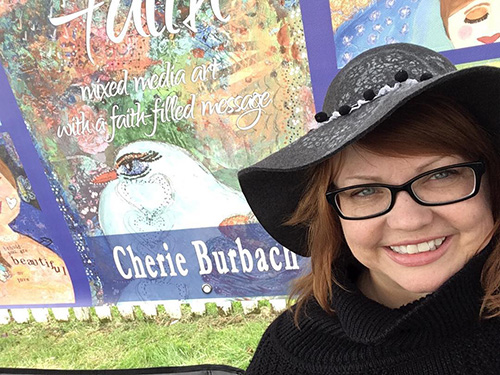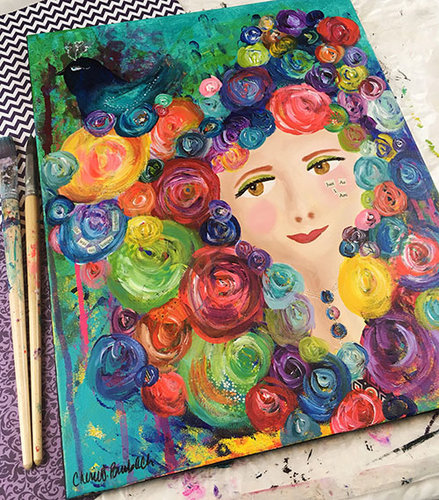by Carolyn Edlund
How does a full-time artist earn a living? Quite often, by cultivating multiple streams of revenue. We spoke with artist Cherie Burbach, who has developed a business model that includes various markets and income sources.

Painter Cherie Burbach in her art festival booth
AS: How many ways are you selling your artwork?
CB: As many as I can make work! Currently I sell at art fairs, online, in artsy shops and galleries, and in exhibits. I also teach in-person classes and offer e-courses. I’ve done a bit of licensing in the past (and am currently looking for a new licensing partner). And I sell art-related books print-on-demand. My approach is to have different “items” to sell (originals, prints, etc.) and also have different selling options where people can purchase them.
AS: Of those revenue streams, which have you found to be the most lucrative?
CB: Right now, art fairs and wholesale (artsy shops and galleries) are the most lucrative for me. I’m doing about 25 art fairs this year.

Work in progress “Some Children Must Travel” displays Cherie’s colorful, uplifting style.
AS: How are you using different income models to complement one another?
CB: I feel that every place you or your art is being seen should help promote something else you’re doing. So at shows I will hand out a schedule of exhibits I’m in or upcoming shows I’m doing. I also encourage signups for my email newsletter by offering things like magnets or keychains. When someone comes to my website, I have links to my shows and art and also have a popup for email signups.
Then, because I encourage email signups I make sure I reward my newsletter subscribers with sales or offerings that are only for them. I keep newsletters short and also uplifting.
I’m on social media quite a bit. I talk about how I’m creating art, where I’m selling, and general thoughts about life.
I’ve always looked at my business as one cohesive brand. So whether I am writing a poetry book or selling art at a show, it is all related.

Cherie Burbach in her studio. The artist uses words that convey inspiring and faith-based messages in her work.
AS: How would you describe the appeal of your work, and your target customer?
CB: For me, words and images have always been connected when it comes to creativity. I’ve been a painter and poet since I was a little girl. My art and writing have always been about offering a positive, hopeful message.
I was given up for adoption and then grew up in an alcoholic household and went through some very turbulent years. Denial is a big part of alcoholic families; maybe for that reason I’m someone who is honest about life. My art is a reflection of what is real, so I have talked about my pain and struggle but I don’t live in it. I believe in answering the negative with something positive. Art is the perfect way to accomplish this.
My experience has helped me understand others who need hope and light. It is about being real and offering something that brings joy. I think that is the appeal of my art and writing.
To me art is just another form of poetry, and you can share this type of sentiment whether you are at an art show or on social media. My target customer is someone who wants to add beauty to their world to help them in their own personal journey. I get lots of letters and people who approach me in my art booth and they share their stories and struggles. To me, this is the biggest blessing of sharing my art with the world.
AS: You’ve said that you can “paint for your market while not compromising your artistic values.” What do you mean by that?
CB: When you find your target customers and where they hang out, everything you naturally do as an artist coincides with what they want from you. While the images and art always have to be what’s on your mind and heart, you can also understand what your customers desire from your art. This becomes the sweet spot of what sells the most. Creating art for your true customers, the ones meant to connect with your art, is like having a conversation with an old friend. It is easy and fun and fills up your soul.

“Bohemian Girl” is an example of Burbach’s focus on whimsical figurative work.
AS: What is your best advice for other artists who are looking to build their own businesses?
CB: First, know that your art is needed in this world. Then, learn to deal with the compliments and detractors in the same exact way. Don’t let the negativity OR positive feedback go to your head or become who you are. As artists, we tend to obsess over the criticism or live for the positive comments. Instead, keep a distance from all of that and put it in perspective. If there is something to be learned from it, you can take the lesson in criticism or achievement but then move on and continue doing your thing.
This is a business that is changing almost daily. Technology and ways to sell and how to promote and it can all get overwhelming. So balance your life to continually learn and be an artist who is not afraid to figure things out (which means making mistakes at times). Then balance this reality with the regular practice of making art. The blessing is always in the doing, so don’t surrender that gift.




Speak Your Mind